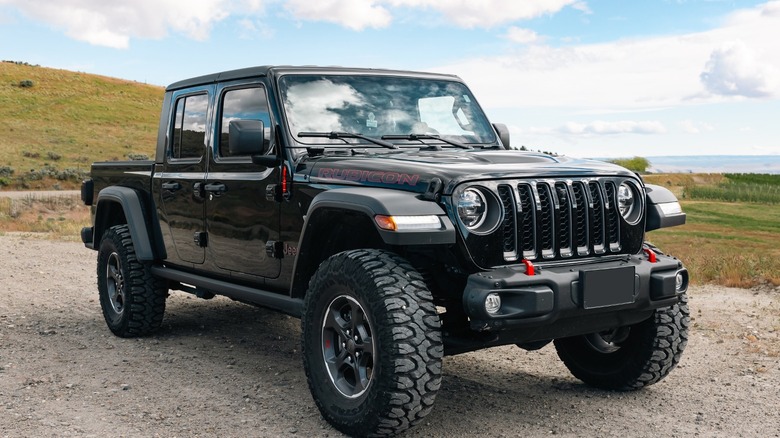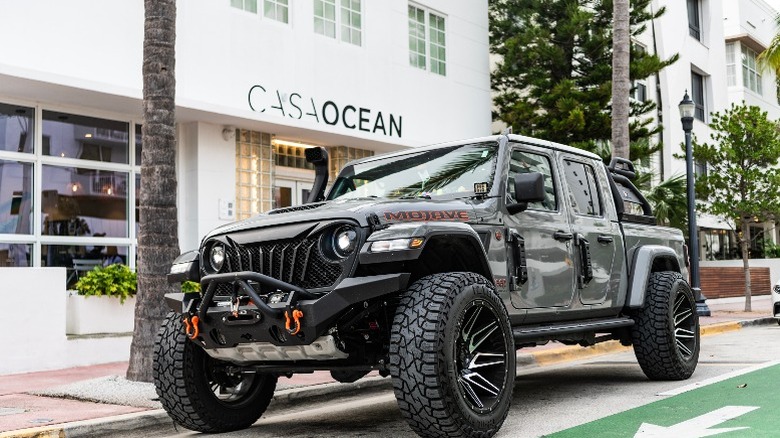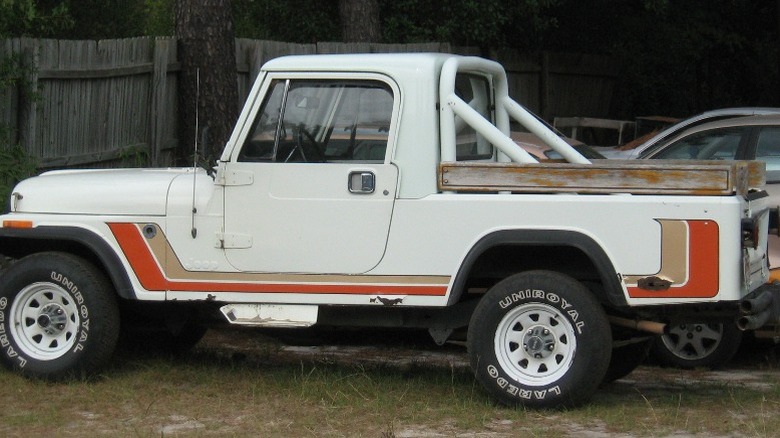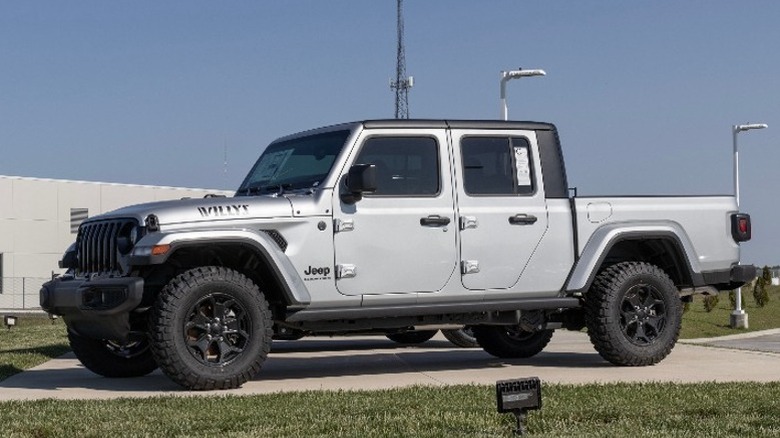10 Of The Best Looking Jeep Trucks Ever Designed
Jeep has been around for almost 80 years and while most of the loyal customers it has gained in that time associate the brand with iconic SUVs like the Cherokee and Wrangler, its lineup is much broader than that. From minivans to rugged pickup trucks, the company has produced a diverse range of quality vehicles throughout its history.
The Jeep was born in the early 1940s in response to the U.S Army needing something versatile during World War II. After the war, the brand transitioned into civilian automobiles, developing vehicles that served a different kind of utility, for farmers and industrial uses. The trucks came in 1947, with the introduction of the Willys Overland truck. Since then, the manufacturer has released about seven truck models, featuring the Scrambler, J-series, CJ-8 Comanche, and Gladiator.
Newer Jeep fans may not be familiar with some of the classic pickups the manufacturer was once known for. This should be no surprise, given that the company halted its truck production for quite a while. Although you might find a few vintage models at auctions, most Jeep trucks you'll find today are Gladiators. And out of these trucks, there are some that have stood out for their looks. With that said, here are 10 of the best-looking Jeep trucks ever designed.
Jeep Gladiator Mojave
First introduced in 1963, the Jeep Gladiator had 26 years of production (combining the Gladiator and J-Series years) before the truck line went dormant for close to three decades. Then in 2020, the Gladiator made a comeback — this time offering a fresh take with modern models and trims, including the Gladiator Mojave. Designed for off-road adventures, the Mojave stands out as a mid-size pickup that blends capability with stylish looks.
The Mojave's exterior stays true to Jeep's classic styling featuring seven-slot grilles, body-colored tow hooks, and 17-inch alloy wheels paired with 33-inch tires. On the interior, the latest model comes with modern specs, including a 12.3-inch infotainment screen and 12-way power seats.
The Mojave is rugged, weighing 4,982 pounds and equipped with a 3.6-liter V6 engine and Fox 2.5 internal bypass shocks to support off-road speeding. The 1.0 front suspension lift enables movement on uneven terrain by providing adequate ground clearance, but also contributes to its taller frame. Overall, this model offers pretty impressive trail strength.
Moreover, the new Mojave X, introduced in 2024, has additional navigation features and a four-wheel drive transfer case to help moderate the power split between the front and rear axles.
CJ8 Scrambler
The CJ8 Scrambler arrived in 1981 — four years after its base model, the CJ-7, was released. Both models were designed based on the Jeep Wrangler and produced only until 1986, giving the CJ-8 quite a short lifespan. So, while we didn't get to witness a lot of this Jeep vehicle, it left a lasting impression thanks to its distinctive look and impressive functionality.
The CJ-8 shared many similarities with its predecessor, but its pickup bed and longer wheelbase set it apart from the CJ-7, which was classified as a compact SUV. This model retained the Jeep off-road functionality, while introducing more utility. It spanned an overall length of 14.7 feet, with a 103.5-inch wheelbase and a simple interior. There were also several trim packages, including the Laredo, Renegade, and Scrambler SR. One of its most iconic versions was the Levi Edition, which featured a denim-upholstered interior.
While the CJ-8 Scrambler has been out of production for quite some time, it's considered one of the best Jeeps of all time, and has become a popular collectible. Its versatility as a compact pickup truck and a daily-use vehicle is also a major reason for its popularity. You're still likely to find this vehicle at online auctions today.
Jeep Gladiator Rubicon
The Rubicon also came as part of the trim offerings of the 2020 Gladiator, and like the Mojave, this model is great for off-road expeditions, but it's even better equipped for rock climbing. The trim embodies ruggedness and tenacity, featuring a 3.6-liter V6 engine, four-wheel drive train, and Dana 44 axles, in addition to offering top-notch features in capacity and looks among Gladiator trims. Starting at $56,930, the Rubicon is one of the priciest models in the Gladiator family, surpassed only by the Rubicon X.
This trim offers a variety of exterior color options. However, it comes standard with a sleek black interior, which complements its tough exterior. The front and rear bumpers are finished in black, creating a bold contrast with the body-colored grille, which features colored accents for a dynamic appearance.
The trim also has different packages that give you access to more personalized options. For instance, in the Dual Top Group package, there are rear sliding windows, a premium black sunrider soft top, and a black three-piece hard top — but this would cost you an additional $3,690.
Jeep J-10 Golden Eagle
In 1971, Jeep set aside the Gladiator name and rebranded its trucks the J-Series, which stayed in production from 1972 to 1988. The design of the J-10 took inspiration from the Wagoneer and Cherokee, which were built on the same platform.
The Golden Eagle Stripe came as an optional appearance package and was made available for the Cherokee, CJ, and the Jeep J-10. While the trim retained many of the standard features found in the base J-10, such as 8-inch wheels and an optional AMC 360 cubic inch V8 engine, what truly set it apart was its bold, distinctive design.
The standout feature of this package was the Golden Eagle decal that spread across the truck's hood. Combined with earthy body colors and gold-painted wheels, the Golden Eagle trim made the J-10 impossible to overlook. Up front, it featured silver grilles, and on the rear, a pickup bed roll bar. For the interior, Jeep also included the iconic Levi denim seats, adding to its vintage flare.
Jeep J10 Honcho
The J-10 Honcho was one of the standout trims offered during the production of Jeep's J-series trucks, alongside the Golden Eagle and 10-4. Appearing for the first time in 1976, this model quickly became one of the most popular and sought-after packages. However, being a limited edition only produced until 1983, the vehicle is pretty hard to find today.
While it shared many of the features of the base J-10 model, opting for the Honcho package gave you additional perks, for an extra $699 ($3,867 in 2024). This trim came in different colors, from the classic black to the Olympic white and navy blue, but you can easily identify the Honcho by the gold stripping on the tailgate and body side, with "Honcho" spelled out boldly on the doors. The interior wasn't left out either, as the cabin featured Levi denim seats and interior carpeting.
Equipped with off-road tires and steel wheels, the Honcho offered a great blend of design and utility. Its AMC 360 V8 engine and four-wheel drivetrain allowed it the ruggedness required for more adventurous driving. Two-bed style options were available on this trim: the townside and the step-bed Sportside.
Jeep Gladiator Sport S
The Gladiator Sport S is one of the entry-level trims introduced with the new Gladiator lineup. However, while it's considered a base model, it still brings a few notable features to the table. Like the other Gladiator trims, it boasts a galvanized steel exterior and a spacious 18-inch deep cargo bed.
This trim shares a lot in common with the Gladiator Sport trim, both having similar engines, transmission, and overall capabilities. Their appearance is not too different either, and they share the same number of color options. However, a few differences make the Sport S stand out a little more, especially when it comes to aesthetics. One of these is the silver-colored aluminum wheels on the Sport S, which is unlike the black steel wheels of the Sport trim.
Jeep also created a slightly different interior for this trim. You get a leather-wrapped steering wheel and on the dashboard, you'll notice window switches at the center, which doesn't appear on the Gladiator Sport. Apart from these, the Sport S offers among the highest number of optional packages on any Gladiator trim, providing extensive customization. The base level for the Sport S is offered at $41,990.
Jeep Gladiator Willys
The 2024 Gladiator Willys starts at $44,995, making it one of the more affordable trims — just above the Sport, Sport S, and Nighthawk models. The pickup truck was designed based on the Wrangler and features a spacious interior and some removable exterior components.
On the exterior, the Gladiator Willys rides on 17-inch black aluminum wheels. The front and rear bumpers match the black shade and are paired with body-colored grilles. Inside, the Willys focuses on both comfort and functionality. The front head restraints are adjustable, and the rear headrests are foldable for added flexibility when loading up the cabin.
One of the great aspects of the Willys trim is how customizable it is — there are a lot of personalization options to explore. The Quick Order Package, costing an additional $7,100, comes with several features, including LED tail lamps, black grille, and body-colored fender flares.
Among the Gladiator models, the Willys does not lead the pack in terms of capacity or fuel efficiency. However, it offers affordable looks, and with some extra investment, you can include functional features like the Emergency Vehicle Alert System (EVAS) and GPS navigation.
Jeep Comanche Eliminator
A lot of people might not be familiar with the discontinued Jeep Comanche, given it was produced for merely 6 years, ending in 1992. This was largely due to the acquisition of the American Motors Corporation (AMC) by Chrysler, which led to some shifts in Jeep's lineup. Given its limited production period, finding a Jeep Comanche today can be challenging, but it remains a cherished model among enthusiasts.
The Comanche was based on the Jeep Cherokee and competed with models like Ford Ranger and Toyota Hilux. With the final model powered by the 4.0-liter inline-six engine, the truck proved quite durable and fuel-efficient. Jeep offered some appearance packages for this model, including the Comanche Eliminator, which was released in 1988.
The Comanche was a beautiful truck, owing its design to one of the top American industrial designers, Dick Teague. The Eliminator trim took a sportier approach than the regular base model, with a 4.0-liter L6 OHV 12V engine and five-speed manual transmission. Appearance-wise, it also had extra touches, such as silver front and rear bumpers and a color-keyed grille. The interior was also enhanced with carpeting on the floor and on the back trim panel.
(Featured image by Shharks via Wikimedia Commons | Cropped and scaled | CC BY-SA 3.0)
Jeep Gladiator Overland
Equipped with a 3.6-liter V6 engine and 18 x 7.5-inch aluminum wheels, the Gladiator Overland is not as great for off-road drives as the Mojave and Rubicon, but it has great technology and overall efficiency. And while this trim was discontinued after 2023, it's still notable for its style and versatility.
The Overland came with a sleek and sophisticated, leather-trimmed black interior. It provided front heated seats to enhance comfort and an optional leatherette steering wheel, as well as up to 10 color options for the crystal metallic exterior. Moreover, with a range of options like rear sliding windows, wheel locks, and bed sliders, you could also add more functional features to the truck.
Optional packages enhanced safety and assistive features. The trailer tow package came with trailer hitch zoom and heavy-duty cooling, and the cold weather group came with remote start systems and a heated steering wheel. Apart from these, the Overland had impressive fuel efficiency, and its weight and tires also appear to have contributed to a smooth riding experience for owners.
Jeep Comanche Pioneer
Offered from 1987 to 1992, the Pioneer was another popular trim for the Comanche. Along with the Eliminator and Sportruck, the Pioneer was one of the few trims that survived for the Comanche's whole production run. Powered by the 2.5-liter L4 OHV 12V, this trim provided a good blend of power and convenience, and unlike the Eliminator it was equipped with a four-wheel drivetrain, providing better power and off-road capabilities.
The Comanche Pioneer was a little over 16 feet long with a 119.6-inch wheelbase. Style-wise, it had the regular cab pickup frame that was common among the Comanche trims. However, the trim also had distinct appearance features and is considered an upgrade from the Sportruck trim.
This package had a simple yet stylish look compared to the Eliminator. On the exterior was a rear step bumper, and on the side was the distinct "pioneer" graphics. Additionally, it came with tinted glass and various available color offerings. The interior was also simple, with vinyl upholstery like the other Comanche trims, but the trim stood out with its sport steering wheel.









